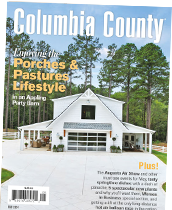 Dreaming of turning your yard into a personal paradise? Several palms native to Georgia thrive here with minimal care.
Dreaming of turning your yard into a personal paradise? Several palms native to Georgia thrive here with minimal care.
There are few sounds in nature as beguiling as the rustle of palm fronds in an ocean breeze, and no other tree sets us dreaming of faraway places quite like the palm.
No tree looks more exotic. Cypress trees may look as timeless and banyan trees may look as tropical, but palm trees look timeless, tropical, and exotically mysterious.
It’s impossible to imagine the Caribbean, the South Pacific or any respectable oasis without palm trees in the picture. If they could talk, palms could probably tell us plenty about dinosaurs and what the Garden of Eden was really like. Palms have seen it all.
Today, homeowners, businesses and golf courses alike feature this tropical icon in their landscapes. Look closer though, and you will usually discover that many of these local palms are not tropical at all but are actually native to Georgia.
Four authentic palms native to the Peach State are the Needle Palm, the Dwarf Palmetto, the Saw Palmetto and the Sabal Palmetto. All are cold hardy, and the Needle Palm is considered the hardiest palm tree in the world.
The advantage all native palms have in common is that they are cold hardy and can handle temperatures below freezing and still recover quickly. The best time to transplant most palms is in spring or summer, when soil temperatures are warmer. Keep in mind that most palms do better in sandy soil — clay holds water and does not warm as quickly.
Sabal Palmetto
The most popular native palm here is the Sabal Palmetto, also called a Cabbage Palm, and you may recognize it as the official state tree of South Carolina and Florida. This hardy palm tree stays green year-round and matures to a height of about forty feet. It is topped with fan-shaped palm fronds that can grow up to five feet long. While they do not have traditional growth rings, it is believed they can live 200 to 300 years.
Sabal Palmetto is easy to transplant, easy to grow and easy to maintain. It grows best in well-drained soils that can be sandy, loamy or clay, but needs lots of sun — it cannot grow in the shade. For tree health (and to keep pests from nesting in the tree), trim the dead palm fronds annually.
Dwarf Palmetto
The fan-shaped Dwarf Palmetto, a shrub-size palm, can live to be more than 400 years old. This smaller relative of the Sabal Palmetto provides a nice anchor in the garden, especially small spaces.
Able to grow in nearly any type of soil, from sand to clay, Dwarf Palmetto tolerates a variety of conditions and is fairly easy to maintain. It has an underground trunk and likes its head in the sun and its feet near the water. Water regularly for its first two years in the ground to allow it to get established. You can expect it to reach a height between two and seven feet with a spread between three and five feet. Prune browning palm fronds to keep the palm healthy.
Needle Palm
The slow-growing Needle Palm is an attractive, low-maintenance, pest-free palm that is easy to grow in just about any landscape. Though it rarely stands higher than eight feet (usually around four to six feet), it is a nearly trunkless palm, almost always appearing as a shrub. It gets its name from the sharp needles on its crown that protect the interior of the plant.
The Needle Palm will grow in both sunny and shady locations but thrives best if given some shade in the afternoon. It loves regular waterings at first but is very drought tolerant once established. Needle Palm stays green year-round and can take temperatures as low as minus ten degrees.
Saw Palmetto
The shrubby Saw Palmetto provides a lush, tropical touch to landscapes and works well as a privacy hedge, foundation planting or backdrop for mixed borders. It usually grows five to ten feet tall and spreads four to ten feet wide. Though typically green, a silver form of this palm is highly prized. Slow-growing and low-maintenance (occasional pruning of dead fronds is all this plant needs), Saw Palmetto is a sun-loving palm but will grow in almost any light. Water regularly after planting until established. Then it will be drought tolerant.
Saw Palmetto is difficult to move once established, however, so be sure to pick the right spot for planting — away from walkways, driveways, play areas, or anywhere the saw-like teeth along the stems might cause harm.
A Popular Non-Native
One major contender on the local palm scene — the Sago Palm — is not native and actually not even a palm. It’s a Cycad, a species that has been around for millions of years and has more in common with ferns than with palms. It’s easy to understand its popularity, though. With a big branching trunk and dark olive leaves that are three to four feet long, it’s very easy to grow.
In fact, with a look that is straight from an oasis, the Sago Palm is so luxuriant and palm-like that it’s become one of the area’s leading landscaping plants. Native to southern Japan, it is cold hardy, usually free from pests and prefers a sunny location with sandy soil and good drainage.










